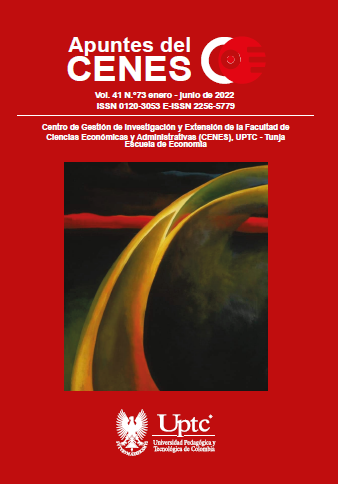Informes de renta variable y los precios de las acciones

Resumen
En este trabajo realizamos análisis de cointegración, con el fin de estudiar si la relación entre las recomendaciones de los analistas y sus ganancias (o pérdidas) de capital proyectadas es consistente con la hipótesis de que las recomendaciones de venta son más costosas que las recomendaciones de compra. Encontramos que las recomendaciones que claramente instan al inversionista a tomar medidas (comprar, vender) son consistentes con sus pérdidas estimadas. También encontramos que las recomendaciones reaccionan levemente a mayores pérdidas proyectadas y fuertemente a mayores ganancias de capital proyectadas, lo cual es consistente con optimismo sistemático. Además, hallamos que pérdidas proyectadas más altas están relacionadas positivamente con la dispersión de recomendaciones. En resumen, notamos evidencia consistente con la hipótesis de Womack (1996) de que el costo de emitir una recomendación de venta es mayor que el costo de una recomendación de compra.
Palabras clave
analistas sell-side, valor intrínseco, incentivos de trading, valor informacional, acceso a la información
Biografía del autor/a
José Gabriel Astaiza Gómez
PhD in Economics
Referencias
- Abreu, D., & Brunnermeier, M. K. (2003). Bubbles and crashes. Econometrica, 71(1), 173-204. https://doi.org/10.1111/1468-0262.00393 DOI: https://doi.org/10.1111/1468-0262.00393
- Allen, F., Morris, S., & Postlewaite, A. (1993). Finite Bubbles with Short Sale Constraints and Asymmetric Information. J. Econ. Theory, 61(2), 206-229. https://doi.org/10.1006/jeth.1993.1067 DOI: https://doi.org/10.1006/jeth.1993.1067
- Budescu, D. V., & Budescu, M. (2012). How to Measure Diversity When You Must. Psychological Methods, 17(2), 215. https://doi.org/10.1037/a0027129 DOI: https://doi.org/10.1037/a0027129
- Cheng, Y, Liu, M. H. & Qian, J. (2006). Buy-Side Analysts, Sell-Side Analysts, and Investment Decisions of Money Managers. The Journal of Financial and Quantitative Analysis, 41(1), 51-83. https://doi.org/10.1017/S0022109000002428 DOI: https://doi.org/10.1017/S0022109000002428
- Cowen, A., Groysberg, B., & Healy, P. (2006). Which Types of Analyst Firms Are More Optimistic? Journal of Accounting and Economics, 41(1-2), 119-146. https://doi.org/10.1016/j.jacceco.2005.09.001 DOI: https://doi.org/10.1016/j.jacceco.2005.09.001
- De Long, J. B., Shleifer, A., Summers, L. H., & Waldmann, R. J. (1990). Positive Feedback Investment Strategies and Destabilizing Rational Speculation. The Journal of Finance, 45(2), 379-395. https://doi.org/10.1111/j.1540-6261.1990.tb03695.x DOI: https://doi.org/10.1111/j.1540-6261.1990.tb03695.x
- https://doi.org/10.2307/2328662 DOI: https://doi.org/10.2307/2328662
- Easterwood, J. C., & Nutt, S. R. (1999). Inefficiency in analysts' earnings forecasts: Systematic misreaction or systematic optimism? The Journal of Finance, 54(5), 1777-1797. https://doi.org/10.1111/0022-1082.00166 DOI: https://doi.org/10.1111/0022-1082.00166
- Francis, J. & Soffer, L. (1997). The Relative Informativeness of Analysts' Stock Recommendations and Earnings Forecast Revisions. Journal of Accounting Research, 35(2), 193-211. https://doi.org/10.2307/2491360 DOI: https://doi.org/10.2307/2491360
- Hilary, G., & Hsu, C. (2013). Analyst Forecast Consistency. The Journal of Finance, 68(1), 271-297. https://doi.org/10.1111/j.1540-6261.2012.01800.x DOI: https://doi.org/10.1111/j.1540-6261.2012.01800.x
- Howe, J. S., Unlu, E. & Yan, X. (2009). The Predictive Content of Aggregate Analyst Recommendations. Journal of Accounting Research, 47(3), 799 - 821. https://doi.org/10.1111/j.1475-679X.2009.00337.x DOI: https://doi.org/10.1111/j.1475-679X.2009.00337.x
- Im K.S, Pesaran M.H. & Shin Y. (2003). Testing for Unit Roots in Heterogeneous Panels. Journal of Econometrics, 115(1), 53-74. https://doi.org/10.1016/S0304-4076(03)00092-7 DOI: https://doi.org/10.1016/S0304-4076(03)00092-7
- Jackson, A. R. (2005). Trade generation, reputation, and sell‐side analysts. The Journal of Finance, 60(2), 673-717. https://doi.org/10.1111/j.1540-6261.2005.00743.x DOI: https://doi.org/10.1111/j.1540-6261.2005.00743.x
- Jegadeesh, N, Kim, J., Krische, S. D. & Lee, C. (2004). Analyzing the Analysts: When Do Recommendations Add Value? The Journal of Finance, 59(3), 1083-1124. https://doi.org/10.1111/j.1540-6261.2004.00657.x DOI: https://doi.org/10.1111/j.1540-6261.2004.00657.x
- Joos, P., Piotroski, J.D., & Srinivasan, S. (2016). Can Analysts Assess Fundamental Risk and Valuation Uncertainty? An Empirical Analysis of Scenario-Based Value Estimates. Journal of Financial Economics, 121, 645-663. https://doi.org/10.1016/j.jfineco.2016.05.003 DOI: https://doi.org/10.1016/j.jfineco.2016.05.003
- Levin, A., Lin, C. F., & Chu, C. S. J. (2002). Unit Root Tests in Panel Data: Asymptotic and Finite-Sample Properties. Journal of Econometrics, 108(1), 1-24. https://doi.org/10.1016/S0304-4076(01)00098-7 DOI: https://doi.org/10.1016/S0304-4076(01)00098-7
- Li, X., Feng, H., Yan, S., & Wang, H. (2021). Dispersion in Analysts' Target Prices and Stock Returns. The North American Journal of Economics and Finance, 56, 101385. https://doi.org/10.1016/j.najef.2021.101385 DOI: https://doi.org/10.1016/j.najef.2021.101385
- Malmendier, U., & Shanthikumar, D. (2014). Do Security Analysts Speak in Two Tongues? The Review of Financial Studies, 27(5), 1287-1322.
- https://doi.org/10.1093/rfs/hhu009 DOI: https://doi.org/10.1093/rfs/hhu009
- Mikhail, M. B., Walther, B. R., & Willis, R. H. (2007). When Security Analysts Talk, Who Listens? The Accounting Review, 82(5), 1227-1253. https://doi.org/10.2308/accr.2007.82.5.1227 DOI: https://doi.org/10.2308/accr.2007.82.5.1227
- Stickel, S. E. (1992). Reputation and Performance Among Security Analysts. The Journal of Finance, 47(5), 1811-1836. https://doi.org/10.1111/j.1540-6261.1992.tb04684.x DOI: https://doi.org/10.1111/j.1540-6261.1992.tb04684.x
- U.S. Department of Labor. (2016-17). Occupational Outlook Handbook, Financial Analysts. Bureau of Labor Statistics.
- Womack, K. L. (1996). Do Brokerage Analysts' Recommendations Have Investment Value? The Journal of Finance, 51(1), 137-167. https://doi.org/10.1111/j.1540-6261.1996.tb05205.x DOI: https://doi.org/10.1111/j.1540-6261.1996.tb05205.x
- Zhang, M. & Zheng, J. (2017). A Robust Reference-Dependent Model for Speculative Bubbles. Journal of Economic Behavior & Organization, 137, 232-258. https://doi.org/10.1016/j.jebo.2017.03.015 DOI: https://doi.org/10.1016/j.jebo.2017.03.015
